Financial Management and Development for Tyre Manufacturing Firm
VerifiedAdded on 2020/02/05
|16
|4415
|388
Report
AI Summary
This report delves into the critical aspects of financial resource management and development, specifically within the context of establishing a tyre manufacturing firm. It begins by identifying and evaluating various sources of finance, both internal (e.g., retained earnings, equity financing) and external (e.g., bank loans, mortgaging), along with their respective implications. The report emphasizes the importance of financial planning, outlining the steps involved and the roles of internal and external decision-makers. It further examines the impact of financial statements, such as profit and loss accounts and balance sheets, on a business's financial appearance. A budgeted cash flow plan for the initial six months of operation is presented, along with a unit cost calculation, and an investment proposal plan. The report underscores the significance of effective financial and pricing structures in achieving business objectives and highlights the need for careful management of financial resources to ensure sustainable growth and profitability. All the above mentioned information is contributed by a student to be published on the website Desklib.
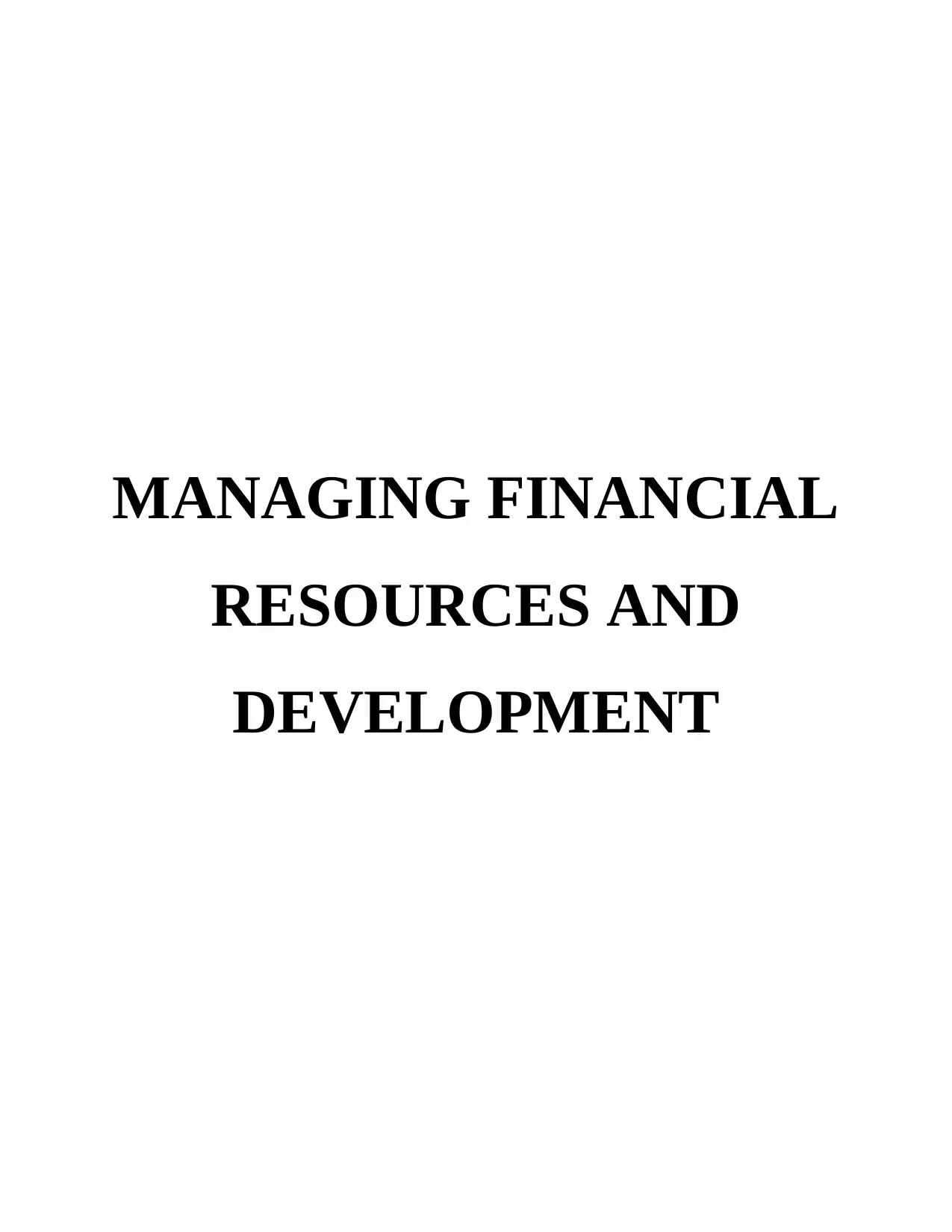
MANAGING FINANCIAL
RESOURCES AND
DEVELOPMENT
L
e
g
a
l
I
L
e
g
a
l
I
RESOURCES AND
DEVELOPMENT
L
e
g
a
l
I
L
e
g
a
l
I
Paraphrase This Document
Need a fresh take? Get an instant paraphrase of this document with our AI Paraphraser
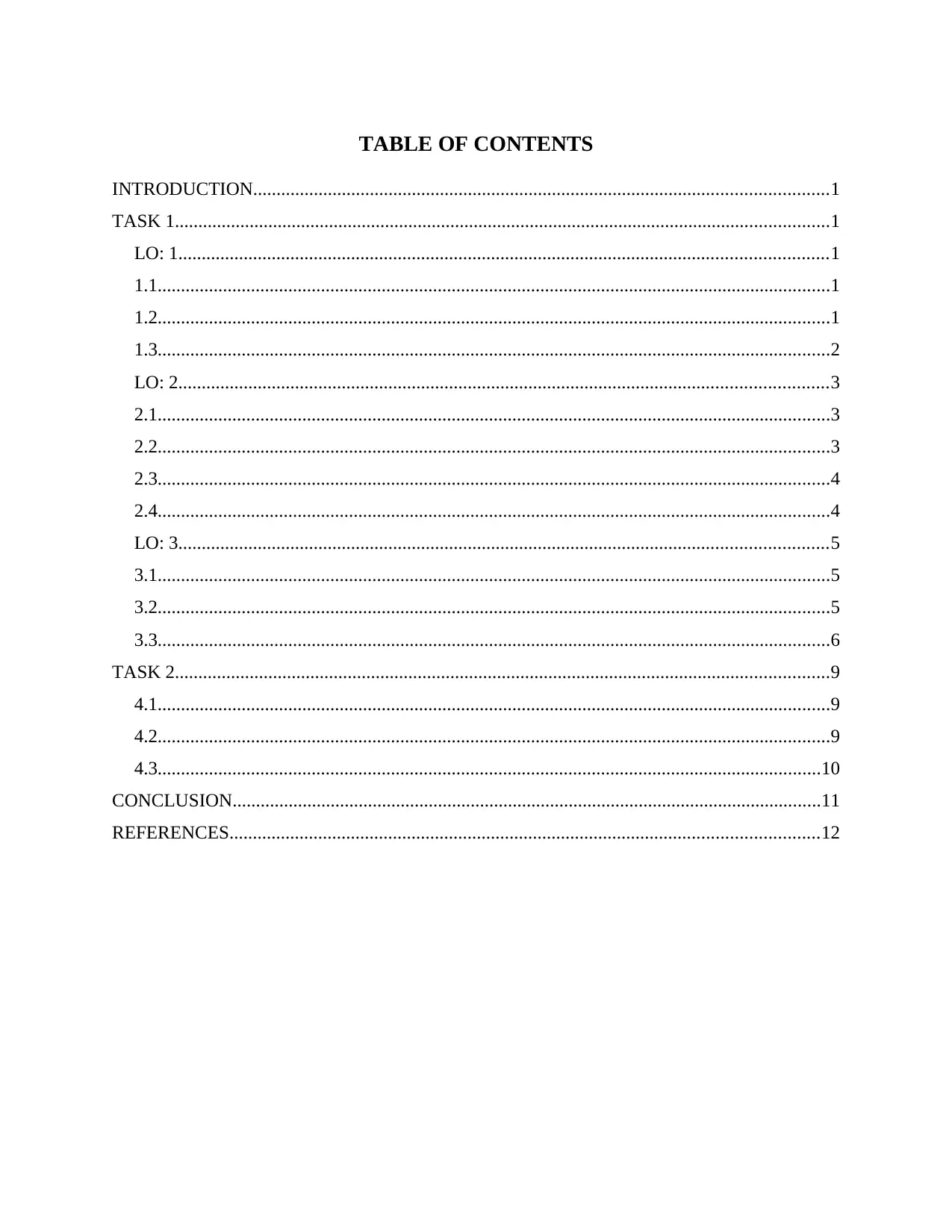
TABLE OF CONTENTS
INTRODUCTION...........................................................................................................................1
TASK 1............................................................................................................................................1
LO: 1...........................................................................................................................................1
1.1................................................................................................................................................1
1.2................................................................................................................................................1
1.3................................................................................................................................................2
LO: 2...........................................................................................................................................3
2.1................................................................................................................................................3
2.2................................................................................................................................................3
2.3................................................................................................................................................4
2.4................................................................................................................................................4
LO: 3...........................................................................................................................................5
3.1................................................................................................................................................5
3.2................................................................................................................................................5
3.3................................................................................................................................................6
TASK 2............................................................................................................................................9
4.1................................................................................................................................................9
4.2................................................................................................................................................9
4.3..............................................................................................................................................10
CONCLUSION..............................................................................................................................11
REFERENCES..............................................................................................................................12
INTRODUCTION...........................................................................................................................1
TASK 1............................................................................................................................................1
LO: 1...........................................................................................................................................1
1.1................................................................................................................................................1
1.2................................................................................................................................................1
1.3................................................................................................................................................2
LO: 2...........................................................................................................................................3
2.1................................................................................................................................................3
2.2................................................................................................................................................3
2.3................................................................................................................................................4
2.4................................................................................................................................................4
LO: 3...........................................................................................................................................5
3.1................................................................................................................................................5
3.2................................................................................................................................................5
3.3................................................................................................................................................6
TASK 2............................................................................................................................................9
4.1................................................................................................................................................9
4.2................................................................................................................................................9
4.3..............................................................................................................................................10
CONCLUSION..............................................................................................................................11
REFERENCES..............................................................................................................................12
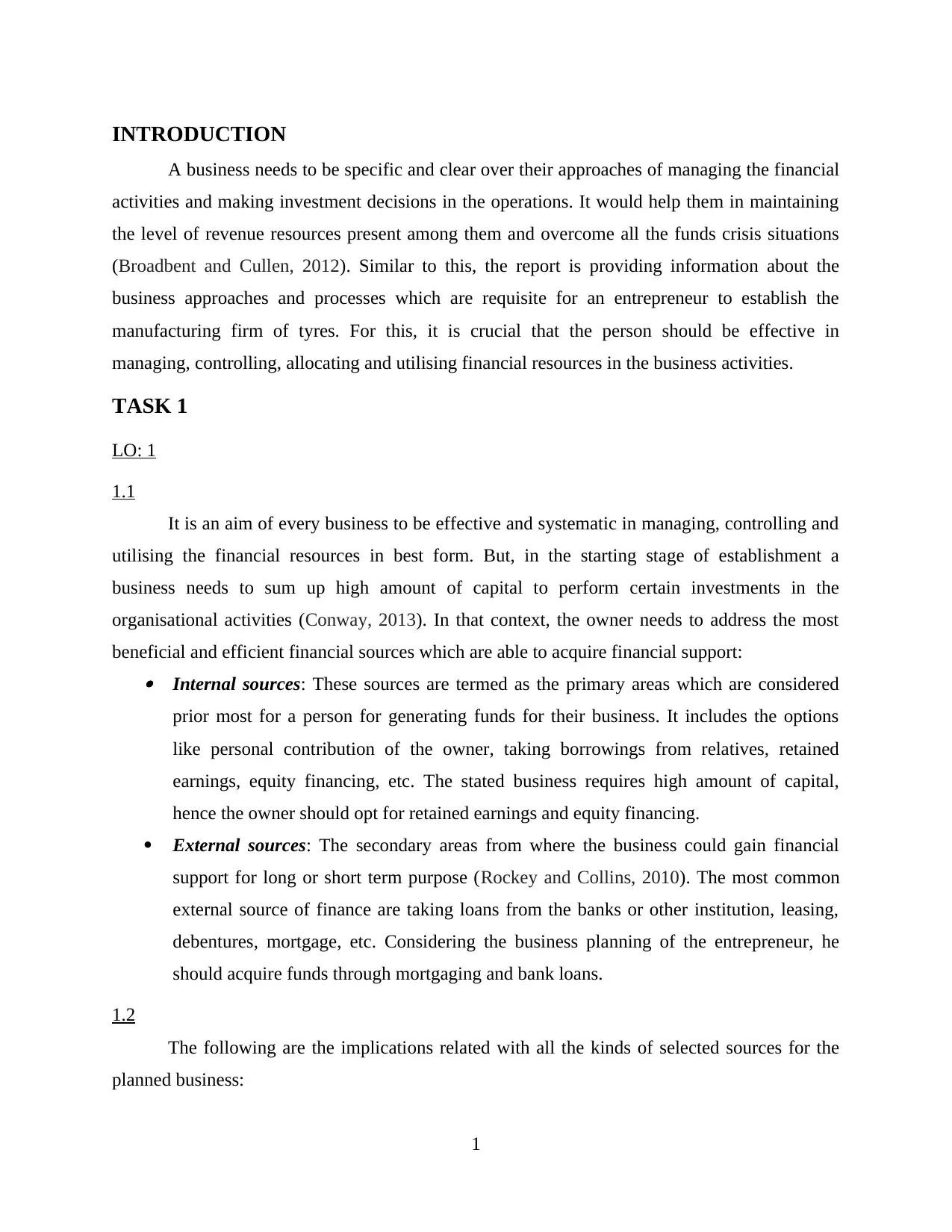
INTRODUCTION
A business needs to be specific and clear over their approaches of managing the financial
activities and making investment decisions in the operations. It would help them in maintaining
the level of revenue resources present among them and overcome all the funds crisis situations
(Broadbent and Cullen, 2012). Similar to this, the report is providing information about the
business approaches and processes which are requisite for an entrepreneur to establish the
manufacturing firm of tyres. For this, it is crucial that the person should be effective in
managing, controlling, allocating and utilising financial resources in the business activities.
TASK 1
LO: 1
1.1
It is an aim of every business to be effective and systematic in managing, controlling and
utilising the financial resources in best form. But, in the starting stage of establishment a
business needs to sum up high amount of capital to perform certain investments in the
organisational activities (Conway, 2013). In that context, the owner needs to address the most
beneficial and efficient financial sources which are able to acquire financial support: Internal sources: These sources are termed as the primary areas which are considered
prior most for a person for generating funds for their business. It includes the options
like personal contribution of the owner, taking borrowings from relatives, retained
earnings, equity financing, etc. The stated business requires high amount of capital,
hence the owner should opt for retained earnings and equity financing.
External sources: The secondary areas from where the business could gain financial
support for long or short term purpose (Rockey and Collins, 2010). The most common
external source of finance are taking loans from the banks or other institution, leasing,
debentures, mortgage, etc. Considering the business planning of the entrepreneur, he
should acquire funds through mortgaging and bank loans.
1.2
The following are the implications related with all the kinds of selected sources for the
planned business:
1
A business needs to be specific and clear over their approaches of managing the financial
activities and making investment decisions in the operations. It would help them in maintaining
the level of revenue resources present among them and overcome all the funds crisis situations
(Broadbent and Cullen, 2012). Similar to this, the report is providing information about the
business approaches and processes which are requisite for an entrepreneur to establish the
manufacturing firm of tyres. For this, it is crucial that the person should be effective in
managing, controlling, allocating and utilising financial resources in the business activities.
TASK 1
LO: 1
1.1
It is an aim of every business to be effective and systematic in managing, controlling and
utilising the financial resources in best form. But, in the starting stage of establishment a
business needs to sum up high amount of capital to perform certain investments in the
organisational activities (Conway, 2013). In that context, the owner needs to address the most
beneficial and efficient financial sources which are able to acquire financial support: Internal sources: These sources are termed as the primary areas which are considered
prior most for a person for generating funds for their business. It includes the options
like personal contribution of the owner, taking borrowings from relatives, retained
earnings, equity financing, etc. The stated business requires high amount of capital,
hence the owner should opt for retained earnings and equity financing.
External sources: The secondary areas from where the business could gain financial
support for long or short term purpose (Rockey and Collins, 2010). The most common
external source of finance are taking loans from the banks or other institution, leasing,
debentures, mortgage, etc. Considering the business planning of the entrepreneur, he
should acquire funds through mortgaging and bank loans.
1.2
The following are the implications related with all the kinds of selected sources for the
planned business:
1
⊘ This is a preview!⊘
Do you want full access?
Subscribe today to unlock all pages.

Trusted by 1+ million students worldwide
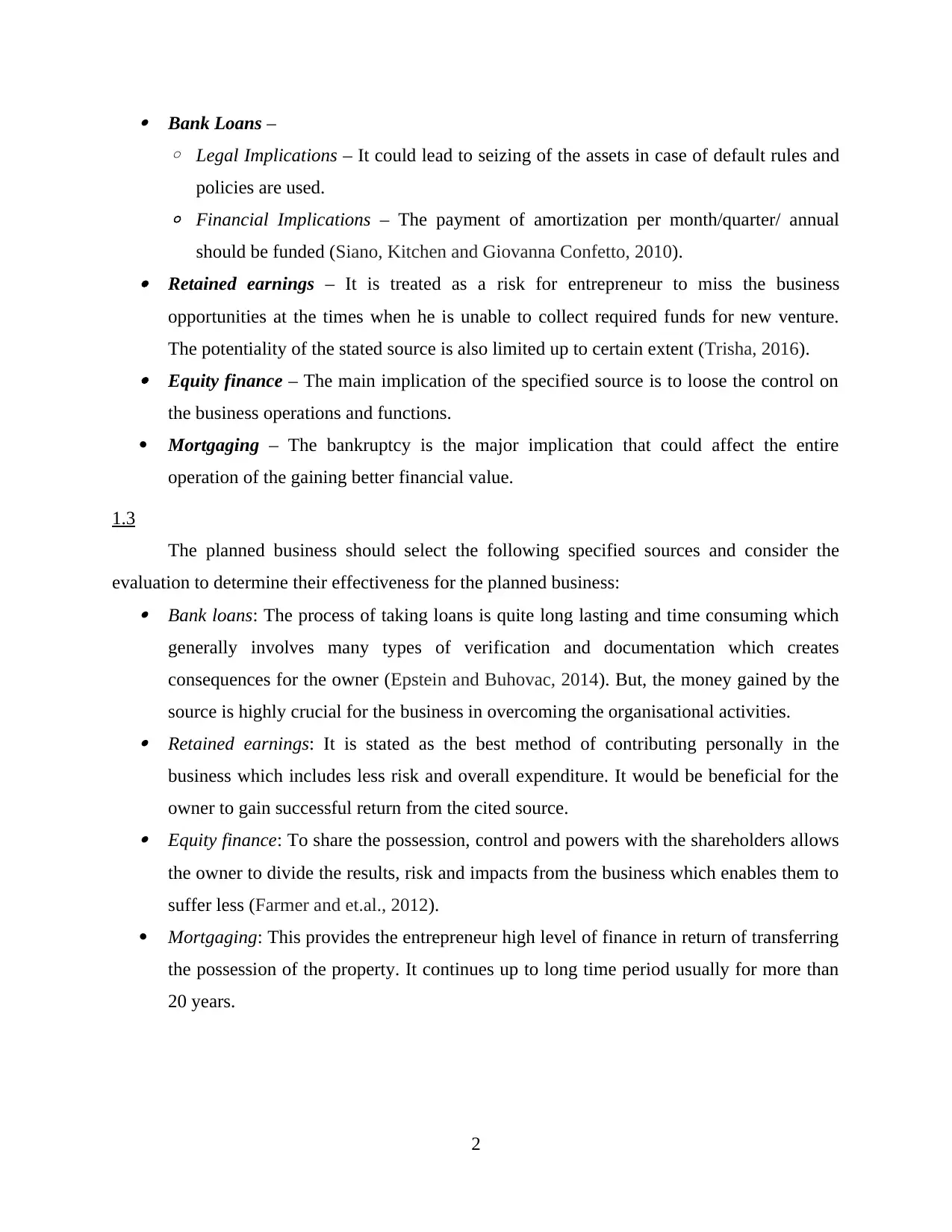
Bank Loans –
◦ Legal Implications – It could lead to seizing of the assets in case of default rules and
policies are used.
◦ Financial Implications – The payment of amortization per month/quarter/ annual
should be funded (Siano, Kitchen and Giovanna Confetto, 2010). Retained earnings – It is treated as a risk for entrepreneur to miss the business
opportunities at the times when he is unable to collect required funds for new venture.
The potentiality of the stated source is also limited up to certain extent (Trisha, 2016). Equity finance – The main implication of the specified source is to loose the control on
the business operations and functions.
Mortgaging – The bankruptcy is the major implication that could affect the entire
operation of the gaining better financial value.
1.3
The planned business should select the following specified sources and consider the
evaluation to determine their effectiveness for the planned business: Bank loans: The process of taking loans is quite long lasting and time consuming which
generally involves many types of verification and documentation which creates
consequences for the owner (Epstein and Buhovac, 2014). But, the money gained by the
source is highly crucial for the business in overcoming the organisational activities. Retained earnings: It is stated as the best method of contributing personally in the
business which includes less risk and overall expenditure. It would be beneficial for the
owner to gain successful return from the cited source. Equity finance: To share the possession, control and powers with the shareholders allows
the owner to divide the results, risk and impacts from the business which enables them to
suffer less (Farmer and et.al., 2012).
Mortgaging: This provides the entrepreneur high level of finance in return of transferring
the possession of the property. It continues up to long time period usually for more than
20 years.
2
◦ Legal Implications – It could lead to seizing of the assets in case of default rules and
policies are used.
◦ Financial Implications – The payment of amortization per month/quarter/ annual
should be funded (Siano, Kitchen and Giovanna Confetto, 2010). Retained earnings – It is treated as a risk for entrepreneur to miss the business
opportunities at the times when he is unable to collect required funds for new venture.
The potentiality of the stated source is also limited up to certain extent (Trisha, 2016). Equity finance – The main implication of the specified source is to loose the control on
the business operations and functions.
Mortgaging – The bankruptcy is the major implication that could affect the entire
operation of the gaining better financial value.
1.3
The planned business should select the following specified sources and consider the
evaluation to determine their effectiveness for the planned business: Bank loans: The process of taking loans is quite long lasting and time consuming which
generally involves many types of verification and documentation which creates
consequences for the owner (Epstein and Buhovac, 2014). But, the money gained by the
source is highly crucial for the business in overcoming the organisational activities. Retained earnings: It is stated as the best method of contributing personally in the
business which includes less risk and overall expenditure. It would be beneficial for the
owner to gain successful return from the cited source. Equity finance: To share the possession, control and powers with the shareholders allows
the owner to divide the results, risk and impacts from the business which enables them to
suffer less (Farmer and et.al., 2012).
Mortgaging: This provides the entrepreneur high level of finance in return of transferring
the possession of the property. It continues up to long time period usually for more than
20 years.
2
Paraphrase This Document
Need a fresh take? Get an instant paraphrase of this document with our AI Paraphraser
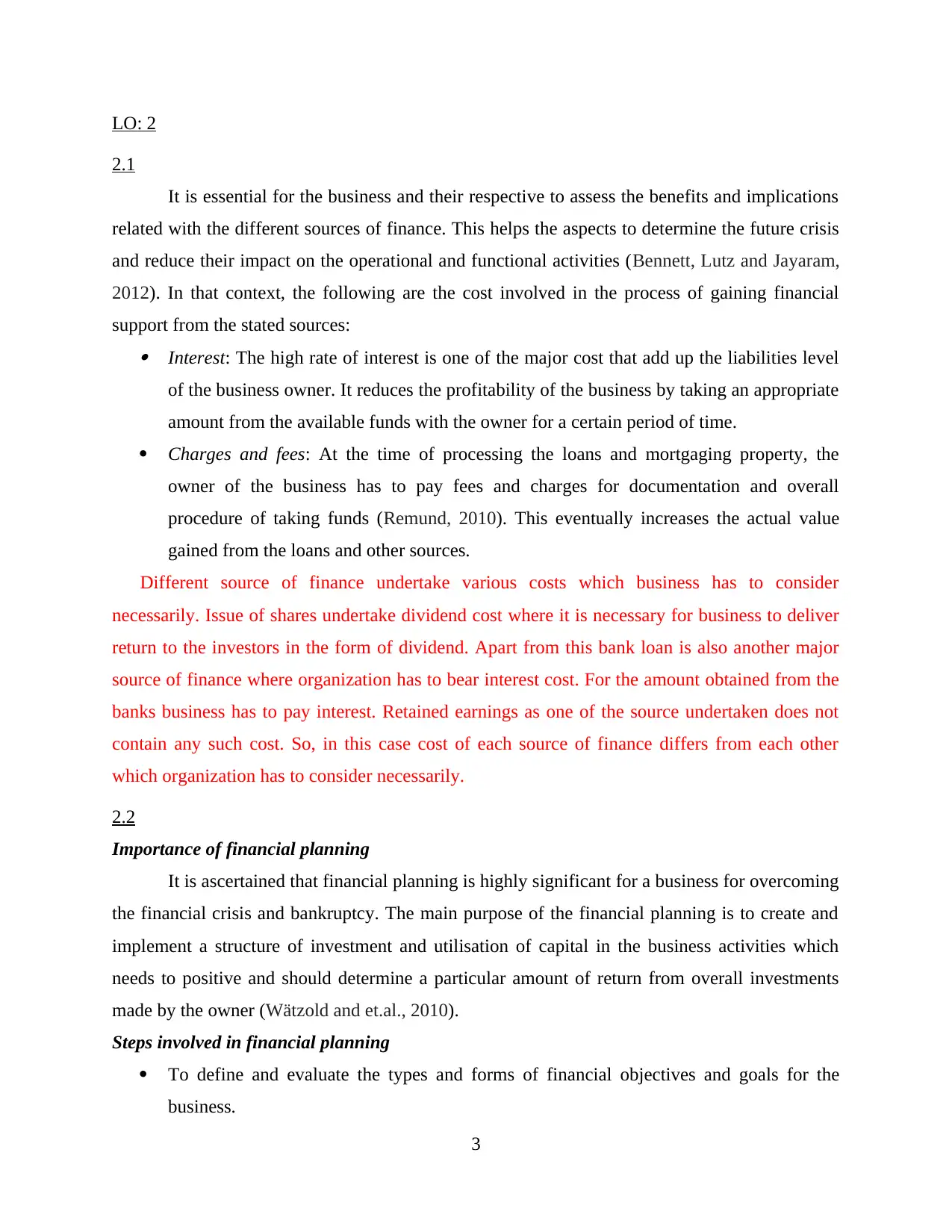
LO: 2
2.1
It is essential for the business and their respective to assess the benefits and implications
related with the different sources of finance. This helps the aspects to determine the future crisis
and reduce their impact on the operational and functional activities (Bennett, Lutz and Jayaram,
2012). In that context, the following are the cost involved in the process of gaining financial
support from the stated sources: Interest: The high rate of interest is one of the major cost that add up the liabilities level
of the business owner. It reduces the profitability of the business by taking an appropriate
amount from the available funds with the owner for a certain period of time.
Charges and fees: At the time of processing the loans and mortgaging property, the
owner of the business has to pay fees and charges for documentation and overall
procedure of taking funds (Remund, 2010). This eventually increases the actual value
gained from the loans and other sources.
Different source of finance undertake various costs which business has to consider
necessarily. Issue of shares undertake dividend cost where it is necessary for business to deliver
return to the investors in the form of dividend. Apart from this bank loan is also another major
source of finance where organization has to bear interest cost. For the amount obtained from the
banks business has to pay interest. Retained earnings as one of the source undertaken does not
contain any such cost. So, in this case cost of each source of finance differs from each other
which organization has to consider necessarily.
2.2
Importance of financial planning
It is ascertained that financial planning is highly significant for a business for overcoming
the financial crisis and bankruptcy. The main purpose of the financial planning is to create and
implement a structure of investment and utilisation of capital in the business activities which
needs to positive and should determine a particular amount of return from overall investments
made by the owner (Wätzold and et.al., 2010).
Steps involved in financial planning
To define and evaluate the types and forms of financial objectives and goals for the
business.
3
2.1
It is essential for the business and their respective to assess the benefits and implications
related with the different sources of finance. This helps the aspects to determine the future crisis
and reduce their impact on the operational and functional activities (Bennett, Lutz and Jayaram,
2012). In that context, the following are the cost involved in the process of gaining financial
support from the stated sources: Interest: The high rate of interest is one of the major cost that add up the liabilities level
of the business owner. It reduces the profitability of the business by taking an appropriate
amount from the available funds with the owner for a certain period of time.
Charges and fees: At the time of processing the loans and mortgaging property, the
owner of the business has to pay fees and charges for documentation and overall
procedure of taking funds (Remund, 2010). This eventually increases the actual value
gained from the loans and other sources.
Different source of finance undertake various costs which business has to consider
necessarily. Issue of shares undertake dividend cost where it is necessary for business to deliver
return to the investors in the form of dividend. Apart from this bank loan is also another major
source of finance where organization has to bear interest cost. For the amount obtained from the
banks business has to pay interest. Retained earnings as one of the source undertaken does not
contain any such cost. So, in this case cost of each source of finance differs from each other
which organization has to consider necessarily.
2.2
Importance of financial planning
It is ascertained that financial planning is highly significant for a business for overcoming
the financial crisis and bankruptcy. The main purpose of the financial planning is to create and
implement a structure of investment and utilisation of capital in the business activities which
needs to positive and should determine a particular amount of return from overall investments
made by the owner (Wätzold and et.al., 2010).
Steps involved in financial planning
To define and evaluate the types and forms of financial objectives and goals for the
business.
3
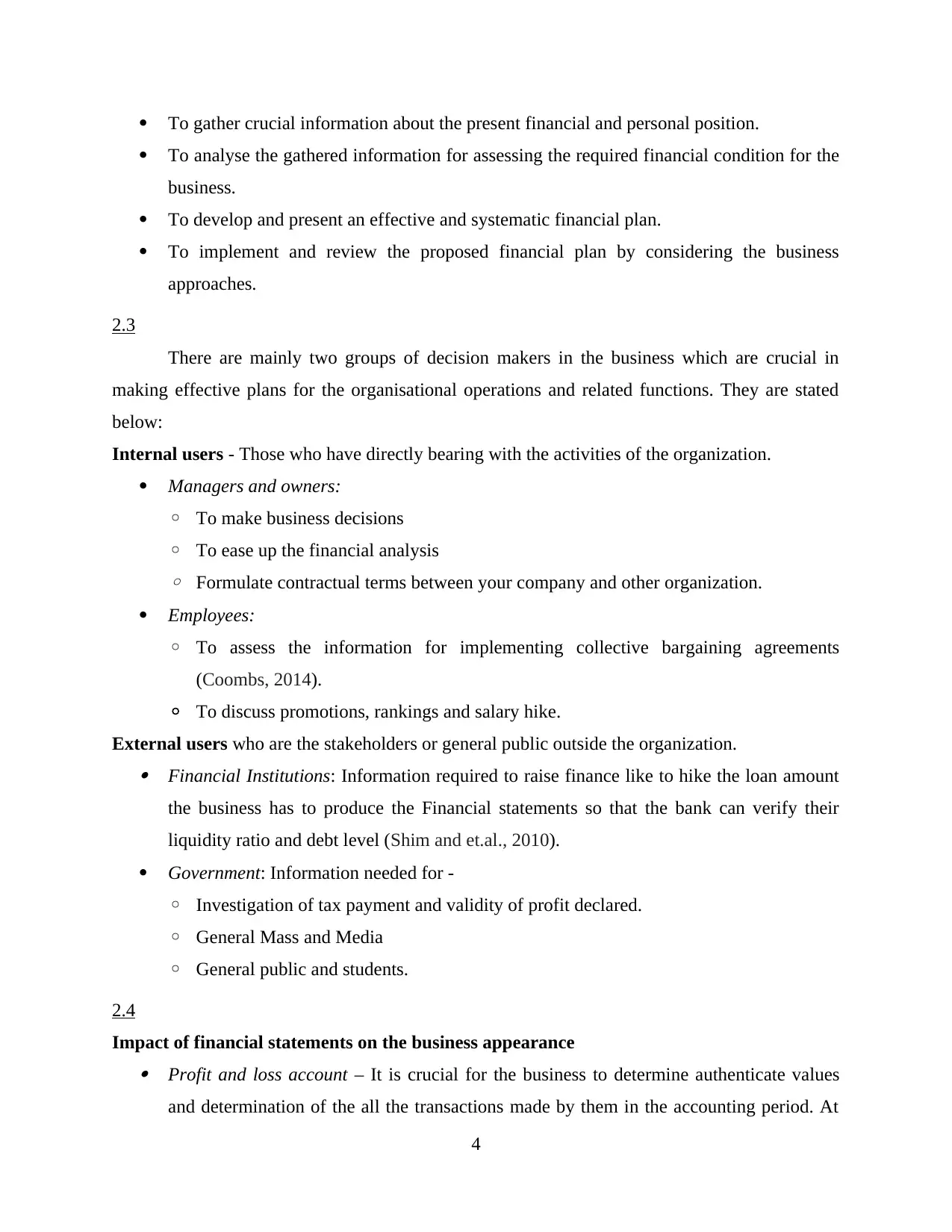
To gather crucial information about the present financial and personal position.
To analyse the gathered information for assessing the required financial condition for the
business.
To develop and present an effective and systematic financial plan.
To implement and review the proposed financial plan by considering the business
approaches.
2.3
There are mainly two groups of decision makers in the business which are crucial in
making effective plans for the organisational operations and related functions. They are stated
below:
Internal users - Those who have directly bearing with the activities of the organization.
Managers and owners:
◦ To make business decisions
◦ To ease up the financial analysis
◦ Formulate contractual terms between your company and other organization.
Employees:
◦ To assess the information for implementing collective bargaining agreements
(Coombs, 2014).
◦ To discuss promotions, rankings and salary hike.
External users who are the stakeholders or general public outside the organization. Financial Institutions: Information required to raise finance like to hike the loan amount
the business has to produce the Financial statements so that the bank can verify their
liquidity ratio and debt level (Shim and et.al., 2010).
Government: Information needed for -
◦ Investigation of tax payment and validity of profit declared.
◦ General Mass and Media
◦ General public and students.
2.4
Impact of financial statements on the business appearance Profit and loss account – It is crucial for the business to determine authenticate values
and determination of the all the transactions made by them in the accounting period. At
4
To analyse the gathered information for assessing the required financial condition for the
business.
To develop and present an effective and systematic financial plan.
To implement and review the proposed financial plan by considering the business
approaches.
2.3
There are mainly two groups of decision makers in the business which are crucial in
making effective plans for the organisational operations and related functions. They are stated
below:
Internal users - Those who have directly bearing with the activities of the organization.
Managers and owners:
◦ To make business decisions
◦ To ease up the financial analysis
◦ Formulate contractual terms between your company and other organization.
Employees:
◦ To assess the information for implementing collective bargaining agreements
(Coombs, 2014).
◦ To discuss promotions, rankings and salary hike.
External users who are the stakeholders or general public outside the organization. Financial Institutions: Information required to raise finance like to hike the loan amount
the business has to produce the Financial statements so that the bank can verify their
liquidity ratio and debt level (Shim and et.al., 2010).
Government: Information needed for -
◦ Investigation of tax payment and validity of profit declared.
◦ General Mass and Media
◦ General public and students.
2.4
Impact of financial statements on the business appearance Profit and loss account – It is crucial for the business to determine authenticate values
and determination of the all the transactions made by them in the accounting period. At
4
⊘ This is a preview!⊘
Do you want full access?
Subscribe today to unlock all pages.

Trusted by 1+ million students worldwide
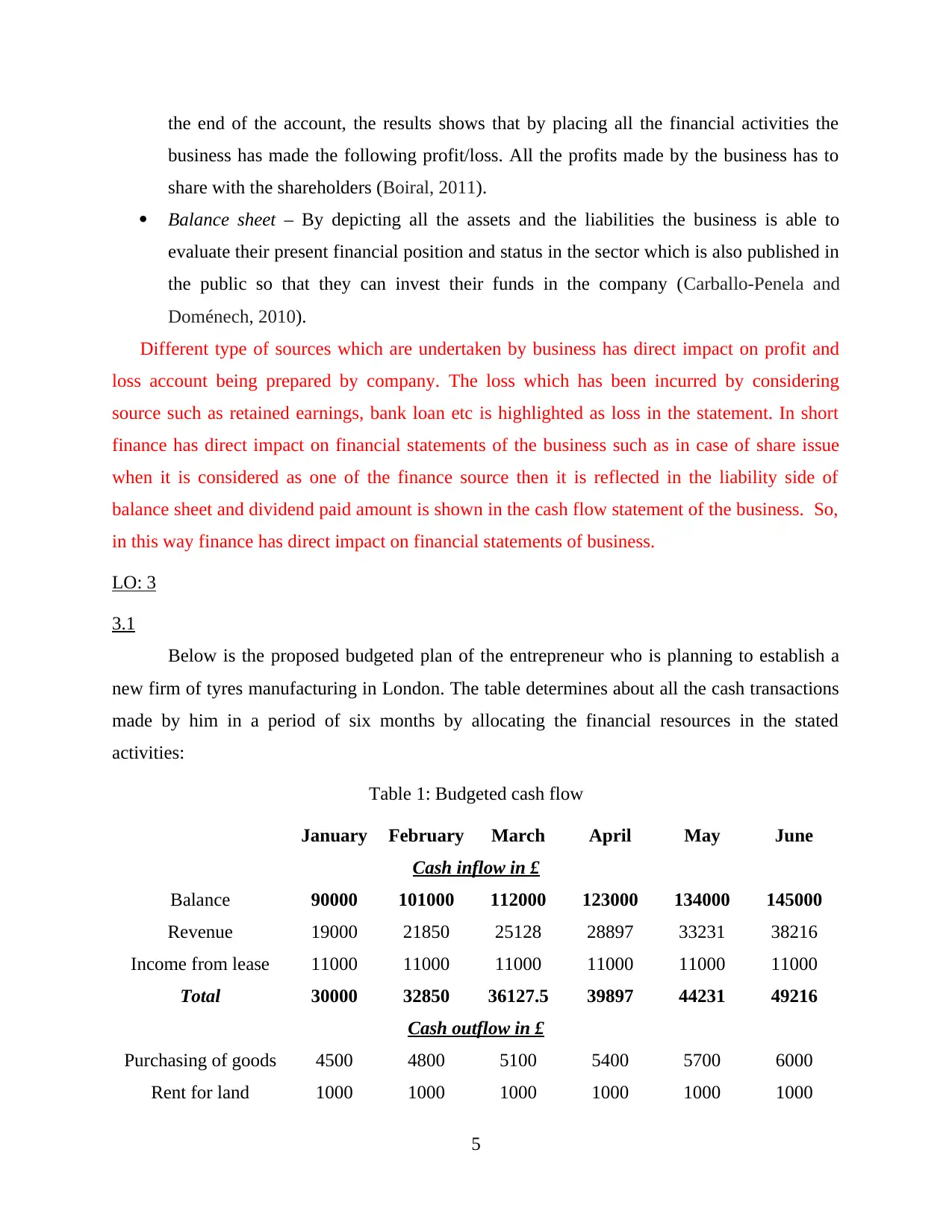
the end of the account, the results shows that by placing all the financial activities the
business has made the following profit/loss. All the profits made by the business has to
share with the shareholders (Boiral, 2011).
Balance sheet – By depicting all the assets and the liabilities the business is able to
evaluate their present financial position and status in the sector which is also published in
the public so that they can invest their funds in the company (Carballo-Penela and
Doménech, 2010).
Different type of sources which are undertaken by business has direct impact on profit and
loss account being prepared by company. The loss which has been incurred by considering
source such as retained earnings, bank loan etc is highlighted as loss in the statement. In short
finance has direct impact on financial statements of the business such as in case of share issue
when it is considered as one of the finance source then it is reflected in the liability side of
balance sheet and dividend paid amount is shown in the cash flow statement of the business. So,
in this way finance has direct impact on financial statements of business.
LO: 3
3.1
Below is the proposed budgeted plan of the entrepreneur who is planning to establish a
new firm of tyres manufacturing in London. The table determines about all the cash transactions
made by him in a period of six months by allocating the financial resources in the stated
activities:
Table 1: Budgeted cash flow
January February March April May June
Cash inflow in £
Balance 90000 101000 112000 123000 134000 145000
Revenue 19000 21850 25128 28897 33231 38216
Income from lease 11000 11000 11000 11000 11000 11000
Total 30000 32850 36127.5 39897 44231 49216
Cash outflow in £
Purchasing of goods 4500 4800 5100 5400 5700 6000
Rent for land 1000 1000 1000 1000 1000 1000
5
business has made the following profit/loss. All the profits made by the business has to
share with the shareholders (Boiral, 2011).
Balance sheet – By depicting all the assets and the liabilities the business is able to
evaluate their present financial position and status in the sector which is also published in
the public so that they can invest their funds in the company (Carballo-Penela and
Doménech, 2010).
Different type of sources which are undertaken by business has direct impact on profit and
loss account being prepared by company. The loss which has been incurred by considering
source such as retained earnings, bank loan etc is highlighted as loss in the statement. In short
finance has direct impact on financial statements of the business such as in case of share issue
when it is considered as one of the finance source then it is reflected in the liability side of
balance sheet and dividend paid amount is shown in the cash flow statement of the business. So,
in this way finance has direct impact on financial statements of business.
LO: 3
3.1
Below is the proposed budgeted plan of the entrepreneur who is planning to establish a
new firm of tyres manufacturing in London. The table determines about all the cash transactions
made by him in a period of six months by allocating the financial resources in the stated
activities:
Table 1: Budgeted cash flow
January February March April May June
Cash inflow in £
Balance 90000 101000 112000 123000 134000 145000
Revenue 19000 21850 25128 28897 33231 38216
Income from lease 11000 11000 11000 11000 11000 11000
Total 30000 32850 36127.5 39897 44231 49216
Cash outflow in £
Purchasing of goods 4500 4800 5100 5400 5700 6000
Rent for land 1000 1000 1000 1000 1000 1000
5
Paraphrase This Document
Need a fresh take? Get an instant paraphrase of this document with our AI Paraphraser
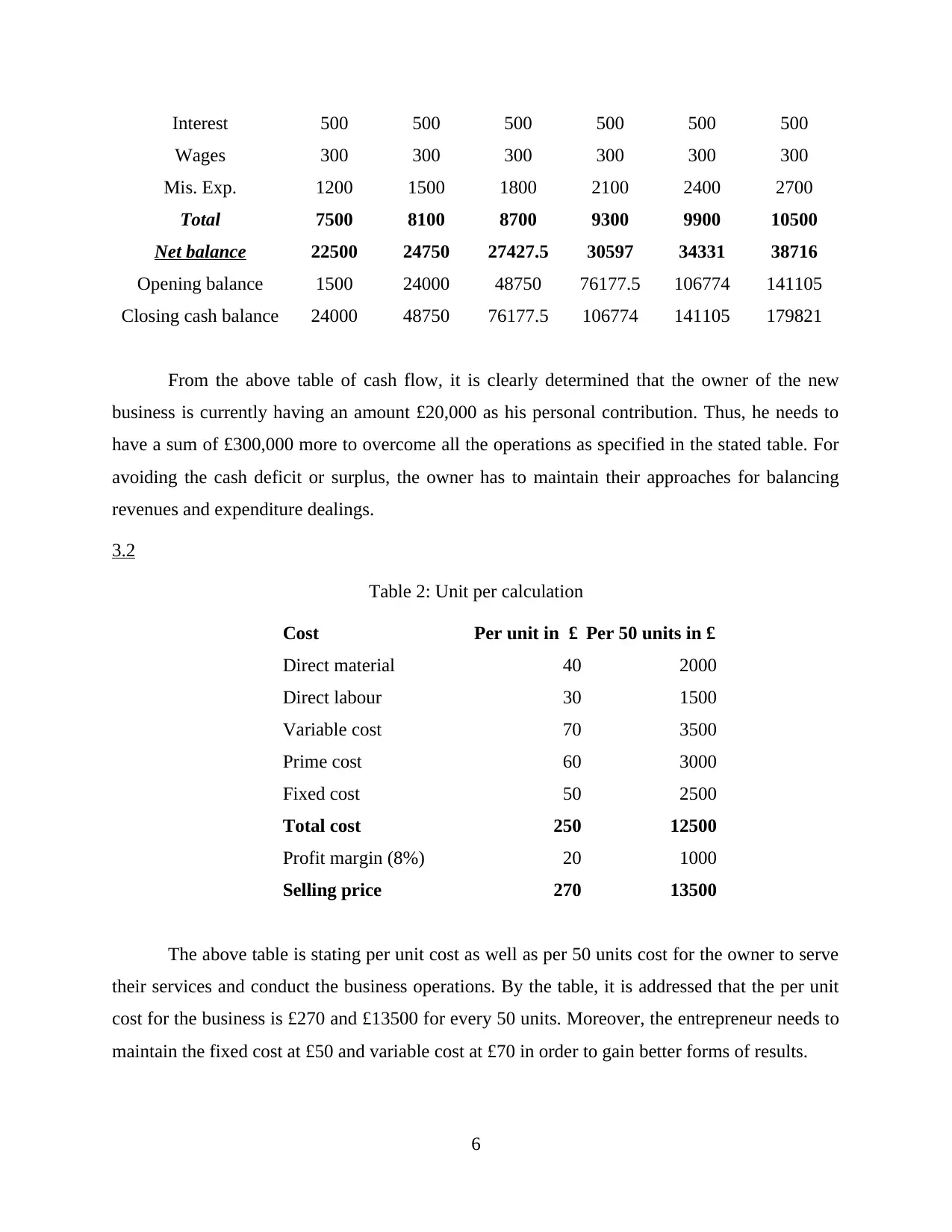
Interest 500 500 500 500 500 500
Wages 300 300 300 300 300 300
Mis. Exp. 1200 1500 1800 2100 2400 2700
Total 7500 8100 8700 9300 9900 10500
Net balance 22500 24750 27427.5 30597 34331 38716
Opening balance 1500 24000 48750 76177.5 106774 141105
Closing cash balance 24000 48750 76177.5 106774 141105 179821
From the above table of cash flow, it is clearly determined that the owner of the new
business is currently having an amount £20,000 as his personal contribution. Thus, he needs to
have a sum of £300,000 more to overcome all the operations as specified in the stated table. For
avoiding the cash deficit or surplus, the owner has to maintain their approaches for balancing
revenues and expenditure dealings.
3.2
Table 2: Unit per calculation
Cost Per unit in £ Per 50 units in £
Direct material 40 2000
Direct labour 30 1500
Variable cost 70 3500
Prime cost 60 3000
Fixed cost 50 2500
Total cost 250 12500
Profit margin (8%) 20 1000
Selling price 270 13500
The above table is stating per unit cost as well as per 50 units cost for the owner to serve
their services and conduct the business operations. By the table, it is addressed that the per unit
cost for the business is £270 and £13500 for every 50 units. Moreover, the entrepreneur needs to
maintain the fixed cost at £50 and variable cost at £70 in order to gain better forms of results.
6
Wages 300 300 300 300 300 300
Mis. Exp. 1200 1500 1800 2100 2400 2700
Total 7500 8100 8700 9300 9900 10500
Net balance 22500 24750 27427.5 30597 34331 38716
Opening balance 1500 24000 48750 76177.5 106774 141105
Closing cash balance 24000 48750 76177.5 106774 141105 179821
From the above table of cash flow, it is clearly determined that the owner of the new
business is currently having an amount £20,000 as his personal contribution. Thus, he needs to
have a sum of £300,000 more to overcome all the operations as specified in the stated table. For
avoiding the cash deficit or surplus, the owner has to maintain their approaches for balancing
revenues and expenditure dealings.
3.2
Table 2: Unit per calculation
Cost Per unit in £ Per 50 units in £
Direct material 40 2000
Direct labour 30 1500
Variable cost 70 3500
Prime cost 60 3000
Fixed cost 50 2500
Total cost 250 12500
Profit margin (8%) 20 1000
Selling price 270 13500
The above table is stating per unit cost as well as per 50 units cost for the owner to serve
their services and conduct the business operations. By the table, it is addressed that the per unit
cost for the business is £270 and £13500 for every 50 units. Moreover, the entrepreneur needs to
maintain the fixed cost at £50 and variable cost at £70 in order to gain better forms of results.
6
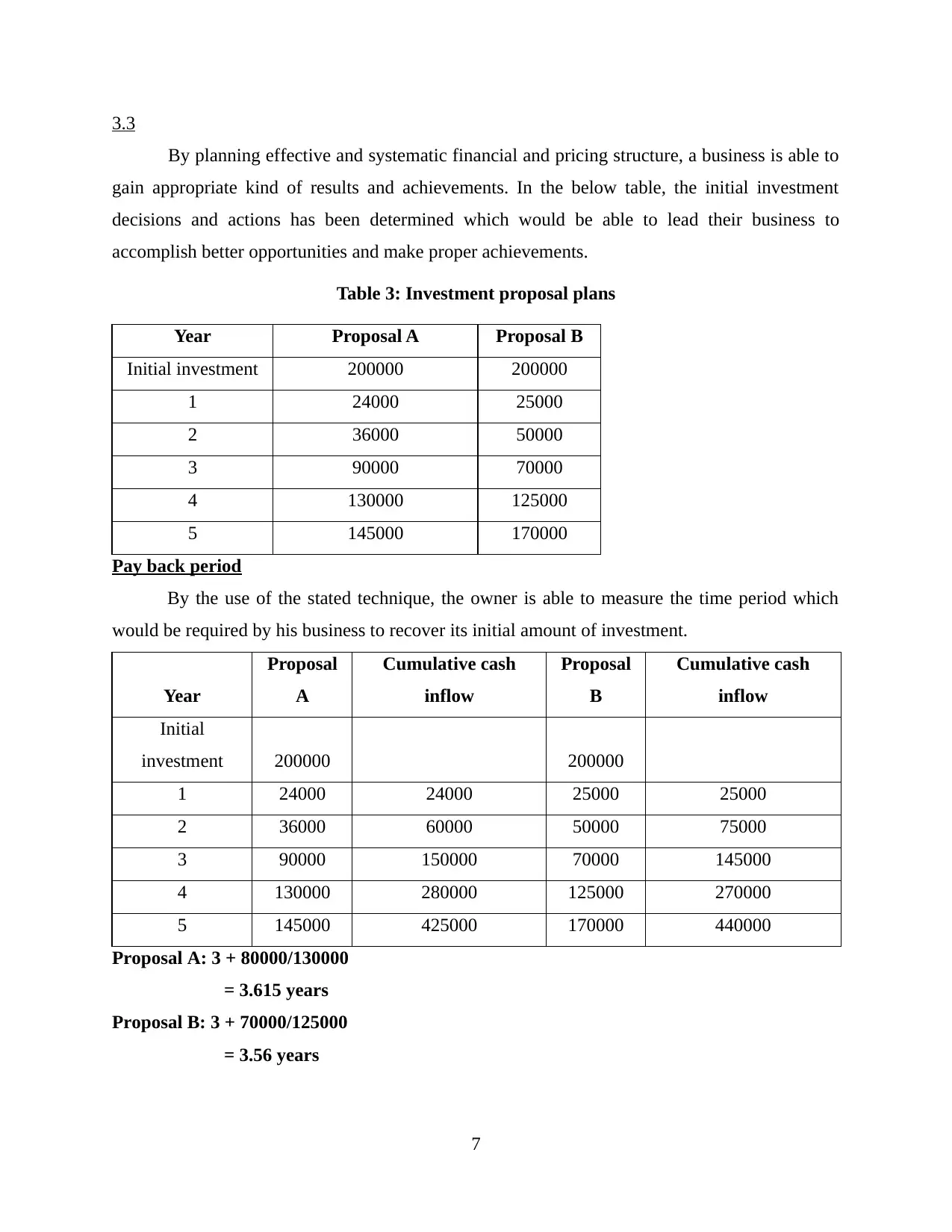
3.3
By planning effective and systematic financial and pricing structure, a business is able to
gain appropriate kind of results and achievements. In the below table, the initial investment
decisions and actions has been determined which would be able to lead their business to
accomplish better opportunities and make proper achievements.
Table 3: Investment proposal plans
Year Proposal A Proposal B
Initial investment 200000 200000
1 24000 25000
2 36000 50000
3 90000 70000
4 130000 125000
5 145000 170000
Pay back period
By the use of the stated technique, the owner is able to measure the time period which
would be required by his business to recover its initial amount of investment.
Year
Proposal
A
Cumulative cash
inflow
Proposal
B
Cumulative cash
inflow
Initial
investment 200000 200000
1 24000 24000 25000 25000
2 36000 60000 50000 75000
3 90000 150000 70000 145000
4 130000 280000 125000 270000
5 145000 425000 170000 440000
Proposal A: 3 + 80000/130000
= 3.615 years
Proposal B: 3 + 70000/125000
= 3.56 years
7
By planning effective and systematic financial and pricing structure, a business is able to
gain appropriate kind of results and achievements. In the below table, the initial investment
decisions and actions has been determined which would be able to lead their business to
accomplish better opportunities and make proper achievements.
Table 3: Investment proposal plans
Year Proposal A Proposal B
Initial investment 200000 200000
1 24000 25000
2 36000 50000
3 90000 70000
4 130000 125000
5 145000 170000
Pay back period
By the use of the stated technique, the owner is able to measure the time period which
would be required by his business to recover its initial amount of investment.
Year
Proposal
A
Cumulative cash
inflow
Proposal
B
Cumulative cash
inflow
Initial
investment 200000 200000
1 24000 24000 25000 25000
2 36000 60000 50000 75000
3 90000 150000 70000 145000
4 130000 280000 125000 270000
5 145000 425000 170000 440000
Proposal A: 3 + 80000/130000
= 3.615 years
Proposal B: 3 + 70000/125000
= 3.56 years
7
⊘ This is a preview!⊘
Do you want full access?
Subscribe today to unlock all pages.

Trusted by 1+ million students worldwide
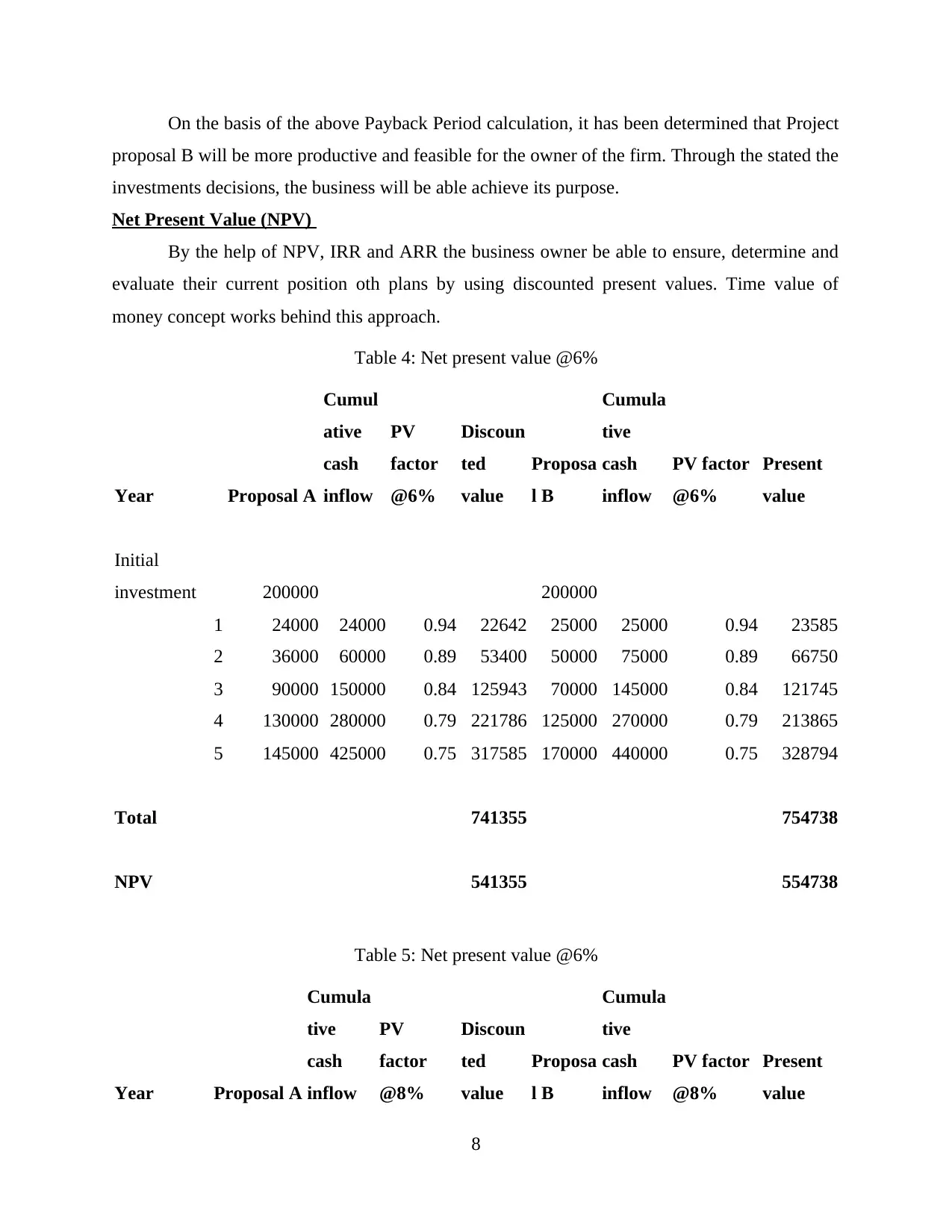
On the basis of the above Payback Period calculation, it has been determined that Project
proposal B will be more productive and feasible for the owner of the firm. Through the stated the
investments decisions, the business will be able achieve its purpose.
Net Present Value (NPV)
By the help of NPV, IRR and ARR the business owner be able to ensure, determine and
evaluate their current position oth plans by using discounted present values. Time value of
money concept works behind this approach.
Table 4: Net present value @6%
Year Proposal A
Cumul
ative
cash
inflow
PV
factor
@6%
Discoun
ted
value
Proposa
l B
Cumula
tive
cash
inflow
PV factor
@6%
Present
value
Initial
investment 200000 200000
1 24000 24000 0.94 22642 25000 25000 0.94 23585
2 36000 60000 0.89 53400 50000 75000 0.89 66750
3 90000 150000 0.84 125943 70000 145000 0.84 121745
4 130000 280000 0.79 221786 125000 270000 0.79 213865
5 145000 425000 0.75 317585 170000 440000 0.75 328794
Total 741355 754738
NPV 541355 554738
Table 5: Net present value @6%
Year Proposal A
Cumula
tive
cash
inflow
PV
factor
@8%
Discoun
ted
value
Proposa
l B
Cumula
tive
cash
inflow
PV factor
@8%
Present
value
8
proposal B will be more productive and feasible for the owner of the firm. Through the stated the
investments decisions, the business will be able achieve its purpose.
Net Present Value (NPV)
By the help of NPV, IRR and ARR the business owner be able to ensure, determine and
evaluate their current position oth plans by using discounted present values. Time value of
money concept works behind this approach.
Table 4: Net present value @6%
Year Proposal A
Cumul
ative
cash
inflow
PV
factor
@6%
Discoun
ted
value
Proposa
l B
Cumula
tive
cash
inflow
PV factor
@6%
Present
value
Initial
investment 200000 200000
1 24000 24000 0.94 22642 25000 25000 0.94 23585
2 36000 60000 0.89 53400 50000 75000 0.89 66750
3 90000 150000 0.84 125943 70000 145000 0.84 121745
4 130000 280000 0.79 221786 125000 270000 0.79 213865
5 145000 425000 0.75 317585 170000 440000 0.75 328794
Total 741355 754738
NPV 541355 554738
Table 5: Net present value @6%
Year Proposal A
Cumula
tive
cash
inflow
PV
factor
@8%
Discoun
ted
value
Proposa
l B
Cumula
tive
cash
inflow
PV factor
@8%
Present
value
8
Paraphrase This Document
Need a fresh take? Get an instant paraphrase of this document with our AI Paraphraser
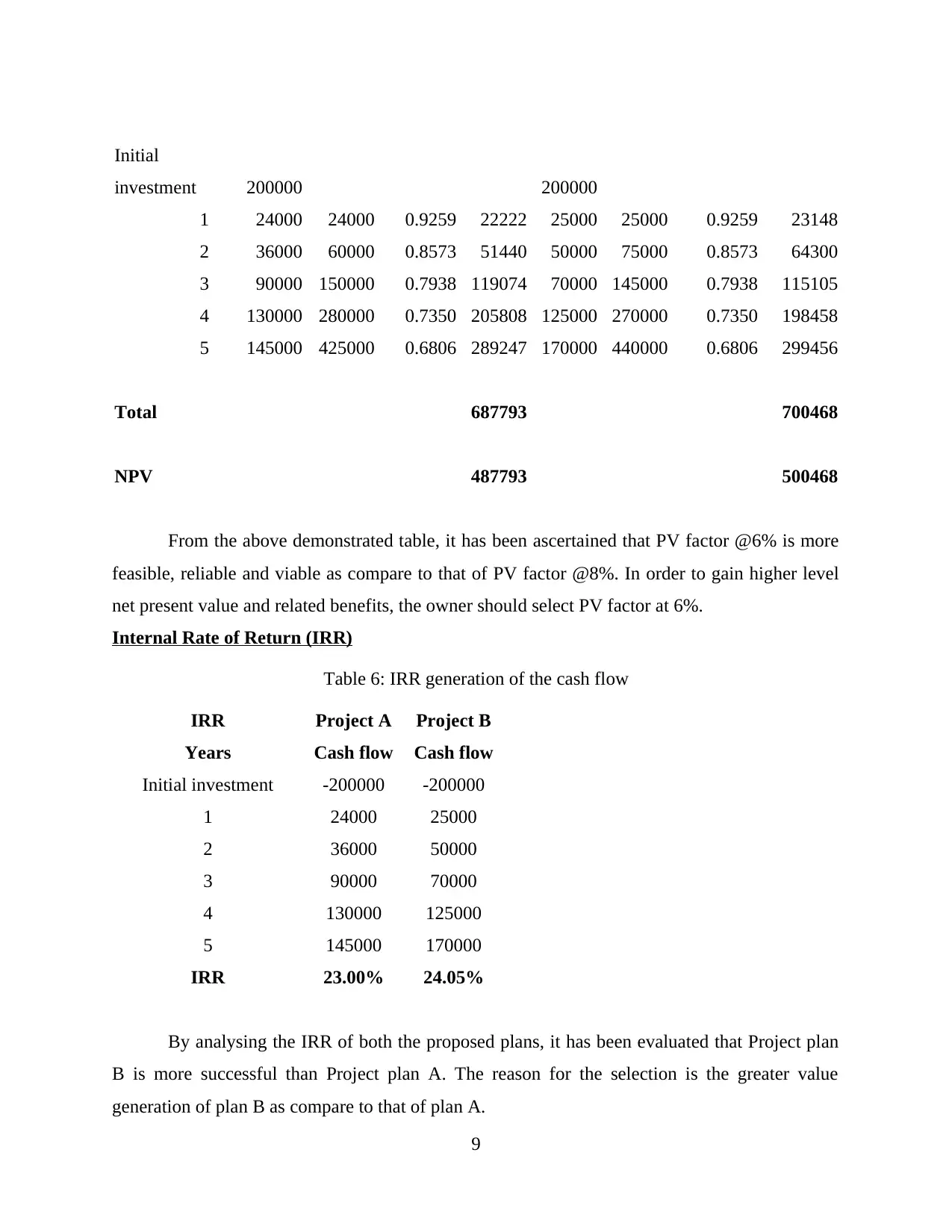
Initial
investment 200000 200000
1 24000 24000 0.9259 22222 25000 25000 0.9259 23148
2 36000 60000 0.8573 51440 50000 75000 0.8573 64300
3 90000 150000 0.7938 119074 70000 145000 0.7938 115105
4 130000 280000 0.7350 205808 125000 270000 0.7350 198458
5 145000 425000 0.6806 289247 170000 440000 0.6806 299456
Total 687793 700468
NPV 487793 500468
From the above demonstrated table, it has been ascertained that PV factor @6% is more
feasible, reliable and viable as compare to that of PV factor @8%. In order to gain higher level
net present value and related benefits, the owner should select PV factor at 6%.
Internal Rate of Return (IRR)
Table 6: IRR generation of the cash flow
IRR Project A Project B
Years Cash flow Cash flow
Initial investment -200000 -200000
1 24000 25000
2 36000 50000
3 90000 70000
4 130000 125000
5 145000 170000
IRR 23.00% 24.05%
By analysing the IRR of both the proposed plans, it has been evaluated that Project plan
B is more successful than Project plan A. The reason for the selection is the greater value
generation of plan B as compare to that of plan A.
9
investment 200000 200000
1 24000 24000 0.9259 22222 25000 25000 0.9259 23148
2 36000 60000 0.8573 51440 50000 75000 0.8573 64300
3 90000 150000 0.7938 119074 70000 145000 0.7938 115105
4 130000 280000 0.7350 205808 125000 270000 0.7350 198458
5 145000 425000 0.6806 289247 170000 440000 0.6806 299456
Total 687793 700468
NPV 487793 500468
From the above demonstrated table, it has been ascertained that PV factor @6% is more
feasible, reliable and viable as compare to that of PV factor @8%. In order to gain higher level
net present value and related benefits, the owner should select PV factor at 6%.
Internal Rate of Return (IRR)
Table 6: IRR generation of the cash flow
IRR Project A Project B
Years Cash flow Cash flow
Initial investment -200000 -200000
1 24000 25000
2 36000 50000
3 90000 70000
4 130000 125000
5 145000 170000
IRR 23.00% 24.05%
By analysing the IRR of both the proposed plans, it has been evaluated that Project plan
B is more successful than Project plan A. The reason for the selection is the greater value
generation of plan B as compare to that of plan A.
9
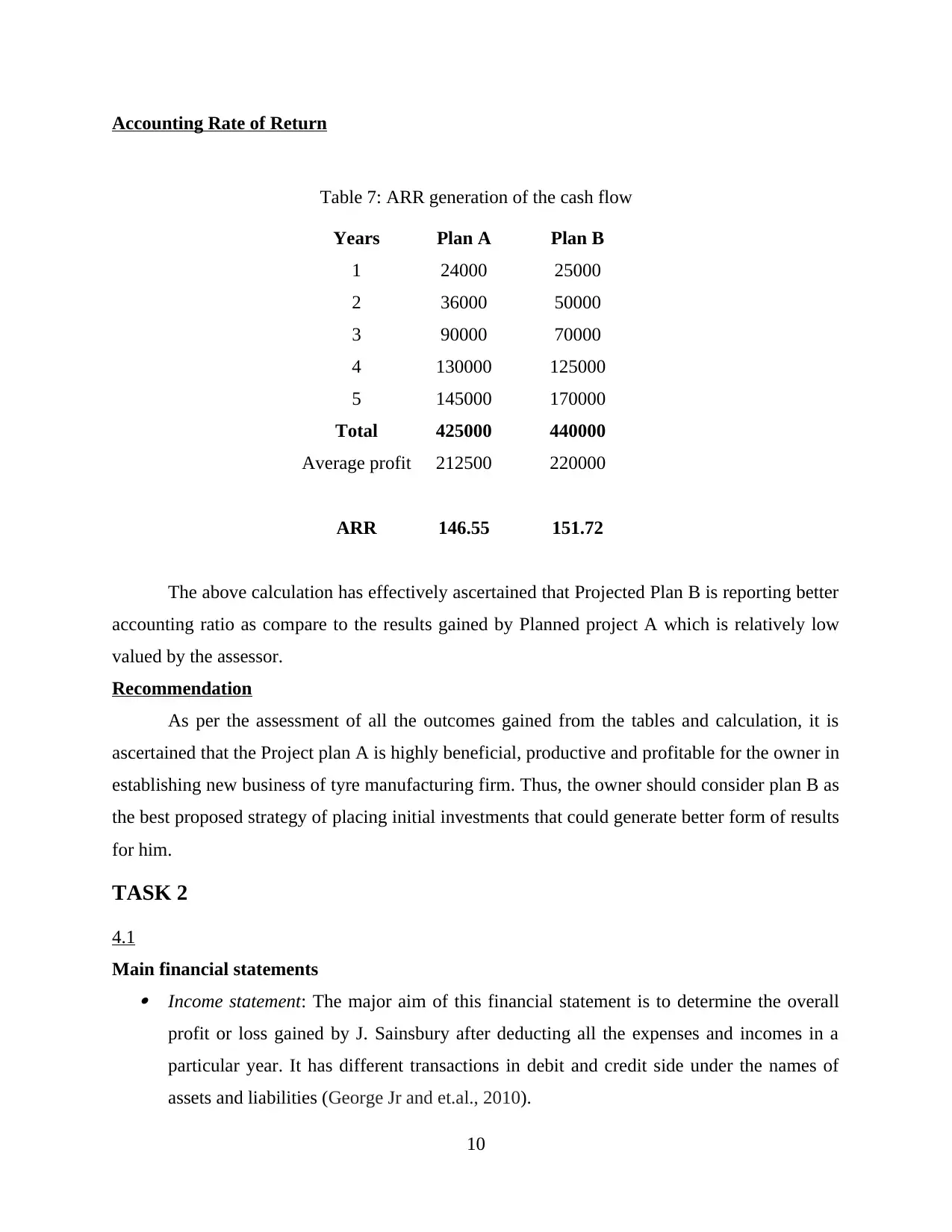
Accounting Rate of Return
Table 7: ARR generation of the cash flow
Years Plan A Plan B
1 24000 25000
2 36000 50000
3 90000 70000
4 130000 125000
5 145000 170000
Total 425000 440000
Average profit 212500 220000
ARR 146.55 151.72
The above calculation has effectively ascertained that Projected Plan B is reporting better
accounting ratio as compare to the results gained by Planned project A which is relatively low
valued by the assessor.
Recommendation
As per the assessment of all the outcomes gained from the tables and calculation, it is
ascertained that the Project plan A is highly beneficial, productive and profitable for the owner in
establishing new business of tyre manufacturing firm. Thus, the owner should consider plan B as
the best proposed strategy of placing initial investments that could generate better form of results
for him.
TASK 2
4.1
Main financial statements Income statement: The major aim of this financial statement is to determine the overall
profit or loss gained by J. Sainsbury after deducting all the expenses and incomes in a
particular year. It has different transactions in debit and credit side under the names of
assets and liabilities (George Jr and et.al., 2010).
10
Table 7: ARR generation of the cash flow
Years Plan A Plan B
1 24000 25000
2 36000 50000
3 90000 70000
4 130000 125000
5 145000 170000
Total 425000 440000
Average profit 212500 220000
ARR 146.55 151.72
The above calculation has effectively ascertained that Projected Plan B is reporting better
accounting ratio as compare to the results gained by Planned project A which is relatively low
valued by the assessor.
Recommendation
As per the assessment of all the outcomes gained from the tables and calculation, it is
ascertained that the Project plan A is highly beneficial, productive and profitable for the owner in
establishing new business of tyre manufacturing firm. Thus, the owner should consider plan B as
the best proposed strategy of placing initial investments that could generate better form of results
for him.
TASK 2
4.1
Main financial statements Income statement: The major aim of this financial statement is to determine the overall
profit or loss gained by J. Sainsbury after deducting all the expenses and incomes in a
particular year. It has different transactions in debit and credit side under the names of
assets and liabilities (George Jr and et.al., 2010).
10
⊘ This is a preview!⊘
Do you want full access?
Subscribe today to unlock all pages.

Trusted by 1+ million students worldwide
1 out of 16
Related Documents
Your All-in-One AI-Powered Toolkit for Academic Success.
+13062052269
info@desklib.com
Available 24*7 on WhatsApp / Email
![[object Object]](/_next/static/media/star-bottom.7253800d.svg)
Unlock your academic potential
Copyright © 2020–2025 A2Z Services. All Rights Reserved. Developed and managed by ZUCOL.





